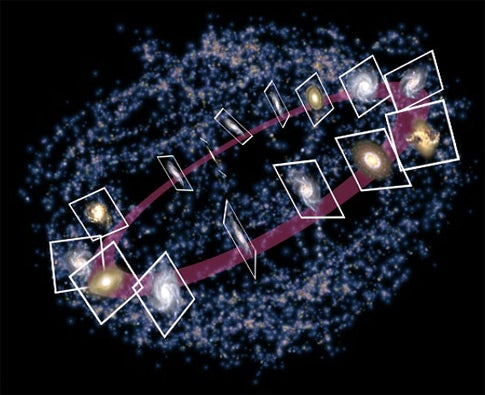Astronomers have known since the early 1990s that galaxies cluster in filaments and sheets surrounding vast voids in space. Now, an international team of astronomers has found that spiral galaxies, like the Milky Way, line up like beads on a string, with their spin axes aligned with the filaments that outline voids. The finding supports current galaxy-formation theories and forges a rare observational link between the large-scale distribution of mass in the universe and galaxy-size structures.
Astrophysicists Ignacio Trujillo at the University of Nottingham in England and Conrado Carretero and Santiago Patiri at the Instituto de Astrofisica de Canarias in Spain made the discovery by studying 470 of the largest voids — galaxy-studded shells hundreds of millions of light-years across. They found the voids by sifting through the two largest studies of galactic redshifts to date: the Sloan Digital Sky Survey and the Two Degree Field Galaxy Redshift Survey.
Earlier researchers had tried to find signs of galaxy alignment in the supergalactic plane — a slab of galaxies that includes the Milky Way — or in more distant planes, but with inconsistent results. Trujillo and his colleagues think those attempts failed because the high velocities of individual galaxies blur the results when Hubble’s Law is used to estimate distances from redshifts. “The planes are smeared out because there is no direct way to translate redshift into distance,” Trujillo says.
He and his colleagues solved that problem by utilizing the largest cosmic voids. “It’s like searching for the pentagons of a soccer ball in a room full of balls,” says Carretero. “It is easier to first find complete balls rather than the pentagons themselves.”
Once they had mapped a void, they could accurately locate its center. The tidal torque theory, which derives a galaxy’s rotation from the uneven distribution of the visible and dark matter from which it coalesces, predicts a galaxy’s axis should be more-or-less perpendicular to the line between the galaxy and the center of the void.
Trujillo’s team found that significantly more spiral galaxies spin with their axes aligned with the filaments they are embedded in than would be expected by chance. Although the researchers can reject random orientation with 99.7-percent confidence, they need more data to specify the range of orientations. The work appears in the 1 April issue of Astrophysical Journal Letters.
“It’s a very interesting finding,” says Alan Heavens, a theoretical astrophysicist at the University of Edinburgh, and it has the potential to tell us more about how galaxies form.










